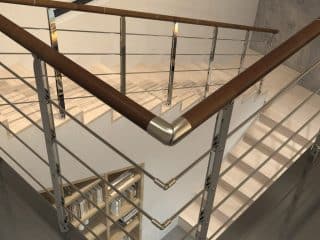Indoor and outdoor railings serve the same purpose of protecting us from falling. Their main purpose is to provide safety and security. Railings are an essential element to both commercial and residential buildings, whether indoor or outdoor.
Wrought iron railings appeared in the 15th century but were less sought after with the arrival of cast iron in the 18th century, when new industrial processes took off. Cast and wrought iron are both used today, along with a number of different materials. Choosing the right material for your railing will be the most important aspect of your search. That’s not all, though, so let’s take a look.










I’m glad you mention that steel railing requires a varnish or paint cover to prevent it from rusting. One of my brothers is renovating his house and needs to install new rails in his staircase. I will pass him the details so he can get the right material for his bars.
I like the idea of using metal for a handrail. My stairs don’t actually have a handrail. These tips could help him find a good one, so thanks for sharing them.
Thank you for sharing some tips! We can use this for steel railings.
It’s awesome that the glass can be treated to have fewer waterspots after it rains. That means you won’t have to clean it nearly as much as I thought you’d have to. I want to get glass because the view we have is amazing and it would be a shame to cover it.
I like that you mention that wood railings offer a nice classic economic option. My husband and I have been wanting to spruce up our backyard for the coming spring and summer. I think building a deck and installing some nice wood railings would be a great way to do that.
I liked how you explained that one can customize the rails when consulting with a professional since some of them might have an app to design your rails. My uncle got his condo renovated and he wants to install new rails because the ones he has are to small and not to secure. I will pass hi the info so he can look for a railing contractor in the area that will customize him the rails he wants.
I didn’t realize that stainless steel is one of the most corrosion resistant materials on the market. My parents have an outdoor staircase that goes from the second floor to ground level. They want to add some metal handrails that will stand the test of time. I will have to tell them about the advantages of stainless steel.
I like the idea of having a glass railing on my deck so I can see the environment better. It will keep people safe from falling off while not messing with the view. I’ll look for a place that sells glass railings before I have my deck built in the coming months so I know I’ll have everything I need.
Thanks for the information I will try this informative and helpful article
Thanks for the tip that mounting options should also be taken into consideration when getting interior railing services. I plan to have some railing at home replaced soon. I’d like to have them be taller so they are not as dangerous for my kids.
This is a great article and you are banged on with your points about choosing the right railing. Be clear about what you really need and want to accomplish at this point- you are right with this point.
Thank you for explaining that glass railings present a nice aesthetic experience as you will be able to see through it the surrounding environment. My mother is planning to have a glass baluster railing on our property. Knowing its benefits now, I think we must have it to also increase the value of our house.